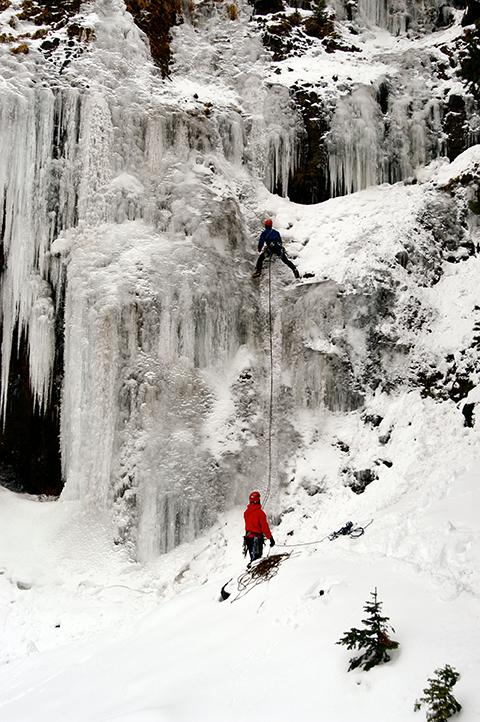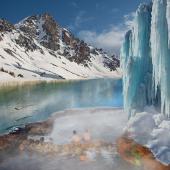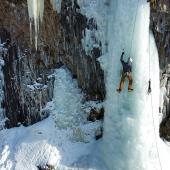An Icy Revelation
“Should we take the transceivers?” Caleb asks.
“I don’t think we’ll need them,” I reply. “The snowpack seems pretty stable. Besides, if there’s a possibility of a slide, we just won’t climb.”
“Good call,” Caleb says. That decided, the beacons are returned to the shelf.
An hour later, my crampons slice through the snow with a reassuring hold on the icy incline. The vista of the surrounding mountains brings a smile to my face. The sun beats down and I can sense the rising temperature. Today will be a warm one. Methodically, I move up the hill, using my trekking poles to help keep my balance on the steep, snowy slope. Our objective for the day—a fat, lengthy iceflow—looms above.
The route appears to be straightforward and in very good condition. Above the flow lies a steep, snow-filled couloir. The snow stability in the couloir doesn’t worry us, mainly because the snow everywhere else seems stable. The only sound penetrating the dead silence of this mountain environment is the tinkling of small ice shards skittering down the iceflow. I give little thought to this disturbance; falling ice is nothing new in ice climbing. At the base of the route I toss my pack on the snow, sitting down to rest.
Caleb soon arrives and together we sort out gear for the climb. We’ve got a rack of seven ice screws and ten quickdraws. We plot our course: the route is two pitches, the first being the longest and easiest, the second being shorter but more difficult.
Once tied into the rope and on belay, Caleb shoulders the rack and starts up the first pitch. He climbs quickly and efficiently, placing screws when necessary, soon arriving at his belay stance. After making a solid anchor with three ice screws, he’s ready to belay and so I tie into the rope.
I glance up to inspect the route. Spindrift flies off the top of the flow, gushing down the ice past my partner and me. The snow streams down the route for a few more moments. I tell myself that these small, inconsequential spindrift avalanches are all that we’ll encounter today. No worries, keep climbing.
I make my way to the top of the first pitch and re-join Caleb. Confident in the anchor, I decide to remove one of the screws—this way, I’ll have a total of five screws for the tougher second pitch. Leading out on the steepening ice, I place a screw, then climb a few meters higher and place another. At this point, I’m climbing up and towards the lefthand side of the flow to avoid an overhanging section of aerated, rotten ice. I reach a good stance, and fire in a solid 19-cm screw. I’m thankful for such a good piece of protection. From here, it’s a short distance to the apex of the flow.
I’m ten meters up from Caleb and close to 60 meters from the ground—this is where the route will deliver the most challenging climbing. Psyching myself up, I prepare for the final push.
Planting both ice tools level with my head, I kick my crampons into the ice and lean back slowly to inspect the portion that lies ahead. A small chunk of ice flies off the top of the flow and out into space; I turn to watch it soar down to the base of the route. Within seconds, more ice chunks and bits of snow bombard me. I look up just in time to see a huge, solid mass of wet snow dropping off the top. Avalanche!
The snow hits my body full-on, knocking me back onto my ice tools. I regain my stance as best I can. Turning to my partner, I shout a warning. He hunches and prepares for impact.
The quantity of avalanching snow increases, and from within the icy cascade I find myself wondering, “Is this really happening? How long will this last? Is this as bad as it’ll get?” My thoughts focus on the disturbing reality that I am helpless to do anything but wait this thing out. Rational and irrational thoughts intertwine. Unable to distinguish one from the other, I move to a state of semi-conscious thought. My world shrinks to a condition of complete focus. I concentrate on hanging on to my tools, sucking my body into the ice to minimize the snow’s impact, and praying that the avalanche will subside. But my prayers go unanswered; the sound and force of the avalanche grows. I hug the iceflow even tighter, my chest pressed firmly against the frozen waterfall.
More and more snow slams into me. I’m driven downward to the ice screw at my waist, and I can’t help but wonder if it will hold. Arms outstretched, I keep a strong grip on my tools. The snow backs off for a moment. I regain my stance. Another torrent of snow assaults my body and the screw is weighted again. Snow flows into my jacket and down my back. I’m cold now. I’m scared. But adrenaline fights off both of these discomforts. I must hang on.
The avalanche continues, delivering the bulk of the snow directly on top of Caleb’s belay. I call down to confirm that he’s okay. His reply is barely audible over the roaring avalanche, but I gather that he’s hanging in there. I can hardly make out his figure below me, hunched over and enduring the tumult. Another torrent. More discomfort and uncertainty. I hug the ice even closer this time—when will it end?
For five impossibly long minutes, the avalanche continues. This period of time forces a major reevaluation of why I climb and the value I place on my life. I suddenly realize that climbing is not all fun and games—things go wrong, and right now, I’m on the receiving end of a major misadventure. But I’m calming now, beginning to accept the eventuality of my decision to climb today. A peaceful cognizance overtakes my mind as I await the large burst of snow that will deliver the fatal consequence. I may die today, but with or without me, the world will keep on turning, the sun will keep on rising, and everyone will continue to live their lives. I accept it all without much reservation.
My placid, fatalistic thoughts are interrupted. Snow no longer assaults my body. Everything is quiet. I warily glance up to the top of the flow, half-expecting another torrent of snow to appear. I wait for a moment. No more snow. I straighten myself up. Is it over? Yes! Thank God.
I breathe slowly, regaining my composure. What now? Get off this iceflow, I tell myself, and quick! I decide to leave an ice screw and carabiner on the route to expedite our departure from the danger zone. I relay the plan to Caleb, and within seconds I’m lowered to the belay. I gather the other two screws on my way down to the belay station.
We quickly decide to have Caleb lower me all the way to the ground. He will then tie our rappel rope to the other one and rappel off the iceflow. We’re playing for all the marbles, as we’ll have to trust that single ice screw to support both our descents. Risky? Yes. Do we care? No. Speed is essential.
I arrive on the ground, untie from the rope, stumble over to my pack, and drop to the ground. Staring at the sky and the surrounding peaks, I immediately gain a personal understanding of the mountains and a deeper respect for the mountain environment. I sit in the snow speechless until Caleb safely reaches the ground. We make little conversation, and I turn my attention to pulling the ropes, packing my bag, and getting away from the iceflow.
The hike down goes smoothly, and we are soon back on the trail, staring up at the iceflow and the fateful couloir above it. Still bewildered, we slog back to the truck, load up, and return to Bozeman. On the way home, I feel thankful for everything I had taken for granted prior to the climb—the sun shining on my face, the clouds floating in the distance, the mountains on the horizon. Most of all, I am thankful to still be an existing entity of this earth.
Back in town, I unpack my bag and lie down. Exhausted but happy, I think about our day. I quickly realize that nature had given us plenty of warning signs: the preliminary chunks of ice flying down from the top of the flow, the warmer temperatures, and the small spindrift avalanche that occurred before the main event. All these were indications that the chute above the flow was not in stable condition. But we didn’t listen to what the mountain was telling us. A mix of naiveté, arrogance, and stupidity (not to mention our unshakable lust for a good climb) put us in a horrifying situation, and we are both lucky to be alive and uninjured.
If there is anything I’ve gained from that day, it’s a renewed sense of why I climb and a renewed sense of respect for the mountains. Above that, I have come to appreciate every day that I’m alive. The mountains are a wonderful and beautiful place to play, but they will always have the upper hand. This ice-climbing season, bear in mind the potential for accidents and misfortune brought on by poor choices. Taking unnecessary risks with something as simple as an ice climb is downright unintelligent, and this incident is proof. So, please let this anecdote serve as a reminder that the mountains are not always to be dealt with audaciously. Be safe, be smart, and have fun!












